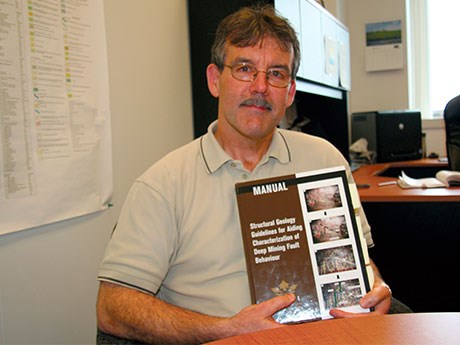Hydraulic fracturing studied as means of dealing with stress buildup
Four oil and gas companies – Nexen, Shell Oil, Conoco Phillips and Anadarko Petroleum Corp. – have joined four mining companies – Vale, Rio Tinto, Newcrest and Sweden’s LKAB – to jointly fund a research project on hydraulic fracturing.
Brought together by the Sudbury-based Centre for Excellence in Mining Innovation (CEMI), the eight companies share a common interest in hydraulic fracturing, but for different reasons.
Currently, the mining industry preconditions ground “by drilling holes around the openings we want to make, then blasting in an effort to drive any stress that’s built up in that area away from where it can cause harm,” explained Damien Duff, CEMI vice-president for geoscience and geotechnical research. Hydraulic fracturing is of interest as a potentially more effective method of dealing with stress buildup in deep underground mines.
The oil and gas industry, on the other hand, uses hydraulic fracturing to free hydrocarbons that are “tightly held within otherwise non-porous and impermeable shale horizons,” noted Duff.
Water and additives are pumped through boreholes that often go down a kilometre, then extend another three to five kilometres horizontally to create fracture networks in the ground through which the hydrocarbons flow back to surface.
The problem though is that the oil and gas industry “never actually gets to see directly what the technology has done,” said Duff. “All they know is that the oil or gas flows better than and sometimes not as well as expected.”
The hydraulic fracturing of a so-called “experimental volume” of 80 by 120 by 60 metres at Newcrest’s Acadia East block cave copper-gold operation in New South Wales, Australia, will allow the oil and gas companies to observe the effects of the fracking and act on any learnings to improve its effectiveness. “In an underground mine, we can look at the area by driving a tunnel through it or by drilling holes through it and observing the drill core,” said Duff.
The oil and gas industry can compare what happens with what they predicted. They can calibrate the numerical modeling techniques they use to make their predictions and adjust how the hydraulic fracturing is performed.
An array of geophysical instruments, including a microseismic sensor system and tilt meters, were installed in and around the experimental volume and a series of observation boreholes were core drilled and logged to discern the state of the ground prior to fracking.
The holes were then grouted with concrete and will be re-cored and re-logged following the fracking to determine how extensive the fractures are and to what extent they have interconnected to create a fracture network.
The three-week fracking experiment at Acadia East was scheduled to begin in February.
Newcrest has been using hydraulic fracturing to induce caving and optimize fragmentation of ore from the drawpoints in its block cave operation at Acadia East, but the company “had never tried to use it to manage the stress distribution around these huge openings,” said Duff. “When they heard that we were planning to research the use of hydraulic fracturing to manage stress distribution and precondition the ground, they were keen to come onboard and take advantage of the opportunity to tap into the know- how of the oil and gas sector.”
Hydraulic fracturing has revolutionized the oil and gas industry by unlocking hydrocarbon resources that have been hitherto unexploitable, but it has also generated controversy and opposition from environmentalists and others who fear contamination of the water table by the chemical additives used in the industry’s fracking recipes.
There are also concerns about the large volumes of water used in the process. The oil and gas industry uses the additives to keep the fractures open and optimize the flow of hydrocarbons, but there is no such requirement for preconditioning ground, so no chemicals will be used in the hydraulic fracturing experiments conducted by CEMI.
According to Duff, fracking by the oil and gas industry occurs hundreds or thousands of metres below the water table and most of the water used returns to surface and is recycled.
Data collected from the Acadia East fracking research will be studied by academics at five universities: Laurentian, Waterloo, Calgary, the University of British Columbia and ETH Zurich.



